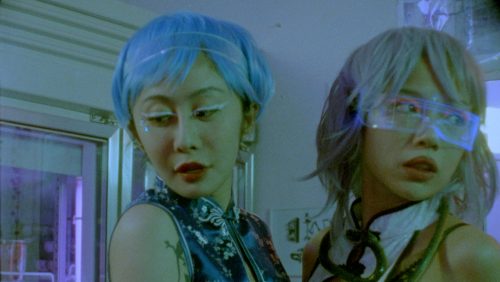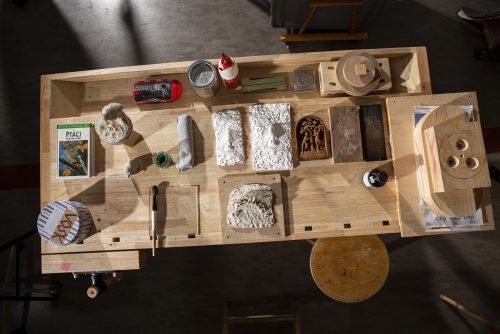
Groupshow
COLLECTION n°15
Project Info
- 💙 INTERIOR and the collectors
- 💚 Christel Montury, Fabien Villon
- 🖤 Groupshow
- 💛 Christel Montury
Share on

Banks Violette, Sybille Ruppert, Photo : Christel Montury
Advertisement

Sybille Ruppert, Untitled, 1987, 24 x 32cm, pencil on paper, Photo : Christel Montury

Banks Violette, No title (gaz-station), 2024, 16 x 15 x 12cm, Photo : Christel Montury

Hr Giger, Michel de broin, Fabien Villon, Catherine Mulligan, Photo : Christel Montury

Catherine Mulligan, Untitled (Ribcage), 2024, 31,75 cm x 24 cm x 3 cm, Photo : Christel Montury

Lama Inca's sculpture, Hr Giger, Michel de Broin, Photo : Christel Montury

Michel de Broin, Bestiaire 2021, bronze, 13 x 16 x 11cm, Photo : Christel Montury

Hr Giger, 1981, Untitled, polaroids, Photo : Christel Montury

Robin Le Forestier, Michel de Broin, Photo : Christel Montury

Fabien villon, Untitled, coper, various dimensions, 2024, Photo : Christel Montury

Catherine Mulligan, vodoo sculpture, Photo : Christel Montury

Hr Giger, Catherine Mulligan, Photo : Christel Montury

Rembrandt, Hr Giger, Photo : Christel Montury

Naga sculpture, Le gentil garcon (The Nice Guy), Photo : Christel Montury

Michel de Broin, Eléctulaire (2021), approx. 18 x 22 x 16cm, bronze, coper, Photo : Christel Montury

Ella mievovsky, Lina Lapelytė, Photo : Christel Montury

Célia Hay, Wake for a horse, film, duration 8 minutes, Super 8 color 4/3, original soundtrack by Kali Malone, Photo : Christel Montury

La Grande décomposition, 2008, 1'45mn stop-motion movie, Photo : Christel Montury

View of the exhibition inside the MUMI, an artwork by Le Gentil Garçon (The Nice Guy), 2016, Photo : Christel Montury

View of the exhibition inside the MUMI, an artwork by Le Gentil Garçon (The Nice Guy), 2016, Photo : Christel Montury
Interior and the collectors asked the artist Le Gentil Garçon (The Nice Guy) to reactivate his miniature museum device (MUMI), produced by Le Voyage à Nantes for the artist's exhibition at the Palais Dobré in 2016. Installed in one of the rooms of the house, this work sits somewhere between a cabinet of curiosities and a modernist-inspired architectural model. By playing with scale and context, it transforms the perception of the artworks: visitors' gaze oscillates between the omniscient view of a surveillance camera and the tiny perspective of a mouse exploring the space.
MUMI also connects to the history of dollhouses, which originated in 16th-century Europe. Intended for adults in the bourgeois elite, these "cabinets of house" were used to display wealth and social status. More than toys, they had an educational function, teaching noble young girls the codes of domestic organization and aesthetic standards. In the 19th century, these houses became toys for children, inviting them to recreate daily scenes or explore imaginary worlds. MUMI, however, reinvents these traditions by offering a playful and intellectual projection experience, playing with museum codes in a space that condenses 3,000 square meters of works into a single room.
This spatial arrangement creates a shift in perspective, transforming the status of each artwork. Freed from any temporal or geographical logic, the displayed objects intertwine in an unexpected dialogue, opening the door to subtle connections and an intuitive, almost irrational, questioning. The selection of artists and works, guided by spontaneous encounters with artists, art dealers, and collectors, reflects a more instinctive approach. From the mystery of a pre-Columbian statuette to the depth of a Rembrandt engraving, through the strangeness of a ritual voodoo object or the vision of contemporary artists, this setup invites each visitor on an introspective and dreamlike journey at the crossroads of cultures and imaginations.
A scent of surrealism lingers, as if awakening the ghost of the avant-garde. The global anxious climate certainly contributes to this invocation, giving rise to works that blow on the embers of an uncertain future. Those by Michel de Broin in bronze and copper stretch and drip in every direction, enveloping organic forms in a mass that seems both liquid and solid. Le Gentil Garçon (The Nice Guy) transforms a bilboquet into a playful vanity, which becomes gigantic in the scale of the miniature museum. The works of HR Giger show another facet of his work with rare 1981 polaroids; one series presents a fully drawn and worn outfit in one of his settings, while another, completely reworked by hand, blurs the image of a woman in an almost abstract whirl. A drawing by Sybille Ruppert, a friend of Giger, veils an enigmatic face, as beautiful as it is nightmarish. Most works reference the body, both as representation and in its flesh, but also through its involvement in a ritual or belief, through presence or absence. Célia Hay evokes a nearly shamanic narrative from the death of a horse in a waking dream impression. Ella Mievovsky presents a set of busts with mysterious headgear straight out of a magical tale and an installation in a bed of sand, resembling a post-apocalyptic refuge, between a precious attachment to material and a gateway to the unknown. Lina Lapelytė installs a sound work, a hypnotic jingle with subtle variations, which resonates throughout the museum and gently seeps into the visitors’ imagination.
The aesthetic of ruin and the traces of an uncertain future are also explored. Banks Violette presents a mental projection of a gas station that has caught fire, a model of a monumental work to come. The result is the remains of an architecture imbued with romanticism, evoking the skeleton of capitalism. Fabien Villon presents a miniature scale accident motorcycle transformed into a rocking horse resting on a burnt plastic rug found on the beach, eroded by salt. A kind of conjuration of shock, where industrial forms metamorphose into raw, organic, and telluric matter. He also presents a collection of 19th-century lightning rods whose ends are deformed by lightning; these objects seem to escape any classification, as if they belonged to a primitive civilization. New York-based painter Catherine Mulligan also maintains a complex relationship with questions of temporality. Her work interrogates visual languages between the precious and the abject, drawing from both the history of Western art and digitized or vernacular images. She presents a nearly emaciated body, with social media icons at the bottom of the painting, counterbalancing the more classical facture of her work. Another bust disturbs this ambiguous relationship with reality, both close and distant from photographic representation. Finally, a negative portrait also challenges what is presented to us, a sort of reversed mirror imbued with nostalgia and unease.
Our concerns can no longer be confined to our immediate environment, as global issues surpass us. This exhibition fits within the constant back-and-forth between the global and the local. Local artists bring their own grounding in this context. Robin Leforestier came to paint miniature paintings, imagining himself inside this miniature museum. He captures, in real-time, all the corners of the room housing the museum, creating a back-and-forth between scales, subtly fluctuating between representation and reality. We invited the santonnier artist Evelyne Ricord to showcase her work, offering a fresh perspective on a traditional, religious sculpture practice, recontextualized in a museum space and placed in dialogue with contemporary artists. In this same spirit of sharing, transcending time and space, ancient works and objects from other civilizations coexist with contemporary artists. In addition to a Rembrandt engraving (1631), we present an Inca gold Lama sculpture from around 1450, a voodoo sculpture from Benin, a carved Naga pipe, Ethiopian headrests, bronze figurines from Thailand, and a pair of nose rings for camels from India (Rajasthan) from the 20th century.
In this miniature museum, this collection of works and ancient objects offers a resolutely metaphysical approach, strengthened by the fact that many of these pieces are offerings or related to religious practices. In their own way, the presented artists also evoke existential questioning through varied forms, sometimes primitive, sometimes refined, such as vanities. This turn toward strangeness and mysticism becomes even more striking when contrasted with the modernist aesthetics of the museum.




